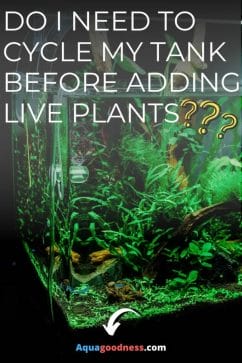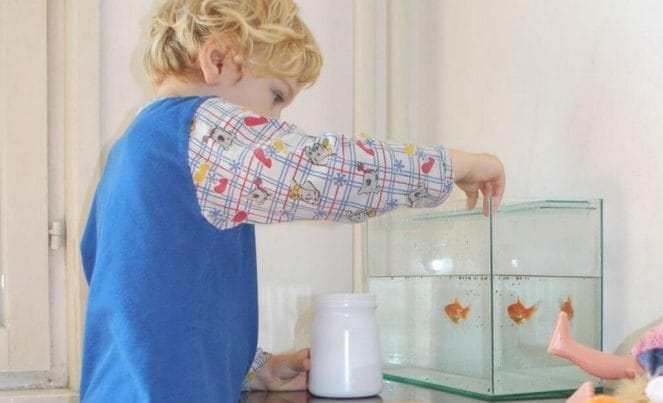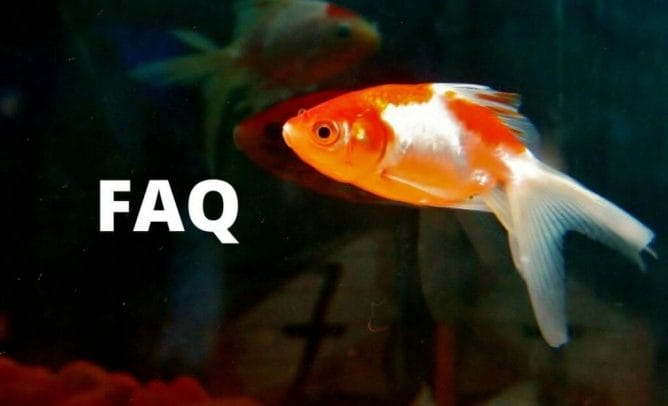If you are wondering, do I need to cycle my tank before adding live plants then you are in the right place.
In this article, I am going to answer the same question.
I will tell you when it is a good idea to put live aquarium plants in your tank before cycling and when it is not.
Lastly, I will also tell you different methods you can use to cycle your planted tank and how plants can help in cycling the tank.
So let’s dive in.

Table of Contents
So, do you need to cycle your tank before adding live plants?
If you are going to plant hardy aquarium plants then you don’t need to cycle your tank before adding live plants.
However, if you are going to plant delicate plants then you need to cycle your tank before planting them.
List of hardy aquarium plants you can plant before cycling the tank
- Amazon sword
- Duckweed
- Java fern
- Java moss
- Anacharis
- Hornwort
- Cryptocoryne wendtii
- Anubias
52 Best Freshwater Aquarium Plants For Beginners (And Care Guide)
Delicate aquarium plants you can’t plant before cycling the tank
- Eriocaulon cinereum
- Hemianthus Micranthemoides
- Glossostigma Elatinoides
- Utricularia Graminifolia
- Elatine hydropiper
- Rotala macrandra
- Rotala wallichii
- Tonina fluviatalis Ecoscape
- Hemianthus Callitrichoides Cuba
12 Benefits of Live Plants in an Aquarium (Pros and Cons)
When it is a good idea to cycle the tank before adding the plants?

There are a couple of scenarios when cycling the tank before adding live plants can be a good idea.
Delicate aquarium plants
As mentioned earlier, if you are going to plant delicate aquarium plants in your tank then you should cycle the tank before adding the live plants into the tank.
Why it is necessary to cycle the tank before adding delicate aquarium plants?
The thing is high ammonia levels can melt delicate aquarium plants.
When a tank is not cycled it contains high ammonia. And when you plant delicate plants in an un-cycled tank the plants will melt by the ammonia.
Also, the process of melting the delicate plants will speed up if you’re using a nutrient-rich substrate because it contains ammonia.
6 Tips to Take Care of Live Plants in Aquarium (For Beginners)
Algae bloom
When you plant live aquarium plants in your tank before cycling the tank, your tank contains a lot of ammonia.
As you have just planted the live aquarium plants in your tank and they’re small. They may not be able to consume all the ammonia in your tank if the ammonia level is pretty high.
So, in this case, the algae will take advantage of the excess ammonia and light that you’re providing to your plants and grow in your aquarium.
This is the reason algae growth is pretty common in new aquarium setups.
And it is considered a good thing because it just shows that your tank is moving forward in the nitrogen cycle process. Which is a good thing!
However, if you want to avoid algae bloom in your tank then you can cycle your tank before adding the live plants in your aquarium.
Another way to avoid algae bloom is to plant fast growing aquarium plants in your tank. They are pretty good at consuming a lot of ammonia if provided with other nutrients and sufficient light.
Are Aquarium Plants Good? (Everything you need to know)
How to cycle a planted tank?
There are a couple of ways to cycle a planted tank. And plants help to cycle the tank.
Fish-in cycling

In-fish cycling is, as the name suggests, is the cycling method in which you will need to introduce fish in your tank to cycle the tank.
First of all, let me tell you the theory behind the “in fish” cycling method.
The theory is this:
You put the fish in the aquarium > Then you start feeding the fish > Then the fish will produce waste in the aquarium > This waste will produce ammonia in your aquarium > Then it will encourage the formation of beneficial bacteria which will convert ammonia into nitrite and nitrate.
The nitrate is least harmful to the fish and your fish can tolerate a lot of it in your aquarium.
So when the cycle is completed your tank will not have any ammonia or any nitrites. But it will have nitrates.
Now to remove the nitrate, you will need to do water change which you should do once a week.
Now, this is the theory and I have explained the whole process in a very simple way. But there is a little bit more into it that we will see below.
Are Aquarium Plants Hard To Keep? (And how to keep them healthy)
How to cycle your tank using the in-fish cycling method? (Step-by-step)
STEP 1
To cycle your tank using the “in-fish” cycling method, first of all, you’ll need to set up your aquarium.
To set up the tank, add the substrate, plant some hardy aquarium plants, and provide light to the plant.
When it comes to providing light to aquarium plants during cycling, you should not provide a lot of light to the plants.
Because, as they are small, they will not be able to take advantage of the bright light.
So if you have plants that do well under low to moderate lighting condition then initially you should keep the lighting low light.
STEP 2
Once you added water into the tank then you should introduce a hardy species of fish into the tank.
In the “in-fish” cycling method it is very important to choose hardy fish. Because ammonia is going to build up in your aquarium which stresses the fish.
And if you choose delicate fish then it will not be able to handle the stress and die in the aquarium.
Usually, people choose goldfish because it is a very hardy fish.
STEP 3
Once you have set up the tank and added hardy fish into the tank. Then you will need to feed the fish.
Initially i.e. for 2 to 3 weeks, you should not feed your fish very frequently.
In fact, you should feed your fish only once in its first week.
Then in the second week you should feed your fish two times, say the first time on Monday, and the second time on Thursday.
Then in the third week, you should feed your fish three times in the whole week. Say you feed the first time on Monday then the second time on Wednesday then the third time on Friday.
Then in the next week, you can feed your fish four times throughout the week. You get the idea!
Now during the cycling period, you should daily or at least every next day check the water parameters using a test kit or test stripe.
You should measure the ammonia level, nitrite level, and nitrate level in your aquarium.
I recommend API freshwater master test kit. It is pretty accurate and it comes with easy to follow instruction manual. You can check the price of the test kit at Amazon here.
Usually, for the initial two weeks, you will see only ammonia levels in your aquarium.
If you see an ammonia level of more than 0.2 PPM then you should do a partial water change of about 50% of your tank.
Now, as you already have some live plants in your tank, the plants will consume some ammonia in your tank.
So you will not need to do the water change very frequently.
As the time passes you will notice low ammonia level and high nitrite level.
This is the sign that beneficial bacteria are started to form in your tank. And it is converting the ammonia into nitrites.
Though nitrite is less harmful to the fish compared to ammonia, it is harmful.
And if you notice nitrite level above 0.2 PPM then you should do 50% partial water change to reduce the nitrite level.
Then after some days, you will notice that your aquarium doesn’t have any ammonia level or any nitrite level but it has nitrate.
Nitrate is least harmful to fish and fish can tolerate high nitrate levels in an aquarium.
And this is the point you can conclude that you are aquarium is cycled.
Though nitrates are very less harmful to your fish and they can tolerate a lot of it.
If your tank exceeds nitrate level more than 40 PPM then you should do a partial water change to reduce the nitrate level in your aquarium.
Do I Need to Fertilize My Aquarium Plants? (Is it really necessary?)
Fishless cycling

Another method of cycling a fish tank is fishless cycling.
In this method, as the name suggests, you don’t need to add fish in your aquarium.
Instead, you need to add any other source of ammonia in your tank like fish food.
The theory behind this process is similar to the above “in-fish” process.
In this process, we’re just using fish food as a source to produce ammonia instead of fish waste.
Are Aquarium Plant Fertilizers Safe For Fish? (Best fish safe fertilizers)
How to cycle your tank with the fishless cycling method?
First of all, you will need to set up your aquarium.
To do that add substrate in your tank. Then plant some hardy live aquarium plants in your aquarium. And then add water in your tank.
Now to produce ammonia in your tank you’ll need to add a little bit of fish food in your tank.
After some time the fish food will break down and produce ammonia in your tank.
The plants will consume some of the ammonia but still, there will be some ammonia in your tank.
After some time the beneficial bacteria will start forming in your tank.
This beneficial bacteria will convert ammonia into nitrites and then into nitrates.
Throughout the cycling process, you will need to test the water of your aquarium daily or every other day with a test kit.
Initially, you will notice ammonia levels in your tank.
Then after a week or so you will notice less ammonia level and some nitrite levels in your tank.
Then after a few weeks, you will start noticing that your tank doesn’t contain any ammonia and nitrites. Instead, it only contains nitrates which is a good thing.
Because at this stage you can conclude that your tank is cycled and ready to introduce inhabitants like fish in your tank.
13 Best Aquarium Plants For Gravel Substrate
How much time will it take to cycle my tank?

Cycling a tank can take anywhere between 4 to 6 weeks depending on the setup.
However, to speed up the process, you can do a few things.
Filter media
If you already have an established aquarium or your friend has an established aquarium then you can pull out the filter media from the filter of that aquarium and add it into your filter.
You can also reach out to your local fish store and ask for filter media from one of their established tanks.
Whatever the source you are getting the filter media just make sure that the tank does not contain any harmful parasites or bacteria. Because if it has then you are accidentally introducing those harmful bacteria and parasites in your tank.
So make sure you are getting the filter media from a trusted source.
Also, while getting the filter media, make sure to put it in a carry bag containing some water. This will help to keep the beneficial bacteria alive until you put the filter media in your filter.
The theory behind getting the filter media and putting it in your filter is that the filter media of the established tank already contains some beneficial bacteria.
So when you add that filter media in the filter your aquarium, you’re basically introducing some beneficial bacteria in your filter.
This beneficial bacteria will breakdown the ammonia into nitrite and then into nitrate.
Also, as you’ve already added some beneficial bacteria in your tank, the bacteria will now replicate quickly.
Overall, it’ll help to speed up the process of the nitrogen cycle.
8 Best Aquarium Plants for Sand Substrate (Easy to Care and Maintain)
Substrate
Another way to introduce beneficial bacteria in your new aquarium to speed up the cycling process is to get the substrate of an established aquarium.
The substrate of an established aquarium will contain some beneficial bacteria.
Just like filter media, make sure that you’re getting the substrate from a tank which is free from any contaminants like harmful parasites, bacteria, or virus.
Also, carry the substrate in a bag containing water to keep the beneficial bacteria alive before putting them in your aquarium.
Do Aquarium Plants Need Light? (Do they really need a special light)
Live plants, fake plants, and ornaments
Beneficial bacteria can also form their colonies on plants and ornaments. So take out some plants and ornaments from an established aquarium. And put them into your new aquarium.
Though the number of beneficial bacteria on the plants and ornaments will be very low compared to filter media or the substrate of the established aquarium. But still, it will contain some beneficial bacteria.
So in this way you can introduce some beneficial bacteria in your tank which will help to speed up the process.
How to Keep Aquarium Plants Alive Before Planting? (3 Easy Ways)
FAQ

Yes, you can put plants in a cycling tank.
Putting some live plants in a cycling tank is actually a good idea because it helps with the cycling process.
Adding some live plants while cycling is especially a good thing if you’re doing “in-fish” cycling.
Because if your tank happens to have a high ammonia level then the plant will absorb some ammonia which will save the fish.
Do Aquarium Plants Need CO2? (Can you keep them without co2)
You should only introduce fish in a new tank if you are doing “in fish” cycling.
Or otherwise, you should only put fish in your new tank when your tank is cycled i.e. your tank doesn’t contain any ammonia and it contains nitrates below 40 PPM.
10 Best Live Plants For Guppies
If you are doing “in fish” cycling then you should put only one fish in your tank to cycle your tank.
Otherwise, if you are doing fishless cycling then you should put the fish in your tank when the nitrogen cycle is completed.
9 Best Aquarium Plants For Shrimp
During the cycling process, you should regularly check the water in your tank for ammonia, nitrites, and nitrates.
After doing the test if you notice that your tank doesn’t contain any ammonia and nitrites but it contains nitrates then it is a sign that your tank is cycled.
7 Best Aquarium Plants For Tetras
20 Tips to Maintain a Healthy Aquarium
Conclusion
Overall, it is not necessary to cycle your tank before adding live plants in your tank.
You can add hardy aquarium plants in your tank before cycling the tank.
However, you should avoid putting delicate aquarium plants before your aquarium is cycled.
I hope you found this article helpful.
If you do, please share it.
Happy aquascaping!